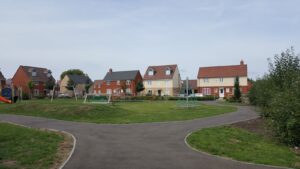Standing up for the neighbourhood
As the latest shake-up of the planning system slowly begins to take shape, the idea of the ‘neighbourhood’ as a hub of civic activity is becoming increasingly central to the government’s vision. But does the everyday experience of the neighbourhood match up to this ambitious ideal?
Living Streets has published new YouGov research indicating that more than a quarter (28%) of British residents say they feel isolated, or have a friend or loved one who does, because of difficulty accessing basic amenities including libraries, shops selling fresh food, post offices, banks and pubs on foot. Nearly half (47%) of those over the age of 55 cannot walk to their nearest GP, with more than half (58%) unable to walk to their nearest bank.
This is an urban and suburban problem as well as a rural one – we’ve had stories sent in from all over the country. As Viv from Worcestershire told us: ‘I live on an estate at the edge of a small town. It is half an hour’s walk to my library, post office, doctors and polling station and I am in an urban area. Where I work there are post offices and libraries nearby – I know more people there than I do at home.
‘When I lived in an area which had a baker, corner shop and polling station within a couple of minutes’ walk, I would walk there, and talk to and acknowledge people as I went. Now I just tend to do shopping on my way from work. I go behind my front door and only go out again if I really have to.’
It’s easy to feel that broader economic conditions make this inevitable. But part of the problem is the ease with which premises can currently change their use. Some surprising changes of use – for example, from a pub to a pawnbroker or a bank to a betting shop – currently require no planning permission under the terms of the Use Classes Order.
As well as depriving people of easy access to the essential local shops and services, residents have little power to prevent undesirable concentrations of uses, such as fast food outlets or betting shops, that can see streets and neighbourhoods decline. Yet our YouGov research found that 81% of British adults think communities should have a say on whether developers change a building’s use in their local area.
Securing that power for communities through the Localism Bill is just one aspect of Living Streets’ campaign for walking-friendly neighbourhoods.
A recent survey by food industry experts IGD noted that whilst just under a quarter of shoppers did all their grocery shopping locally, without the need for a car, another 28% would like to if they could.
Will neighbourhood planning provide a framework for this kind of aspiration? The government’s planning reforms present an opportunity to consider the kind of neighbourhoods we actually want to live in. When we do, we realise how many of the concerns that get people angry, animated and involved are located firmly at the street level.
We notice how far we have to walk to a key destination, whether the streets are clean on the way, how fast the traffic is going, whether people are parking or cycling on the pavement, whether we feel safe and feel like we belong.
The likely scope of neighbourhood plans is yet to become clear. But if the hope is to empower local people to ‘shape the character of the very neighbourhood in which they live’, it’s these street-level issues that will be crucial.
Stand up for your neighbourhood – join the campaign today
(All figures, unless otherwise stated, are from YouGov Plc. Total sample size was 2019 adults. Fieldwork was undertaken between 15th – 17th February 2011. The survey was carried out online. The figures have been weighted and are representative of all GB adults (aged 18+).















